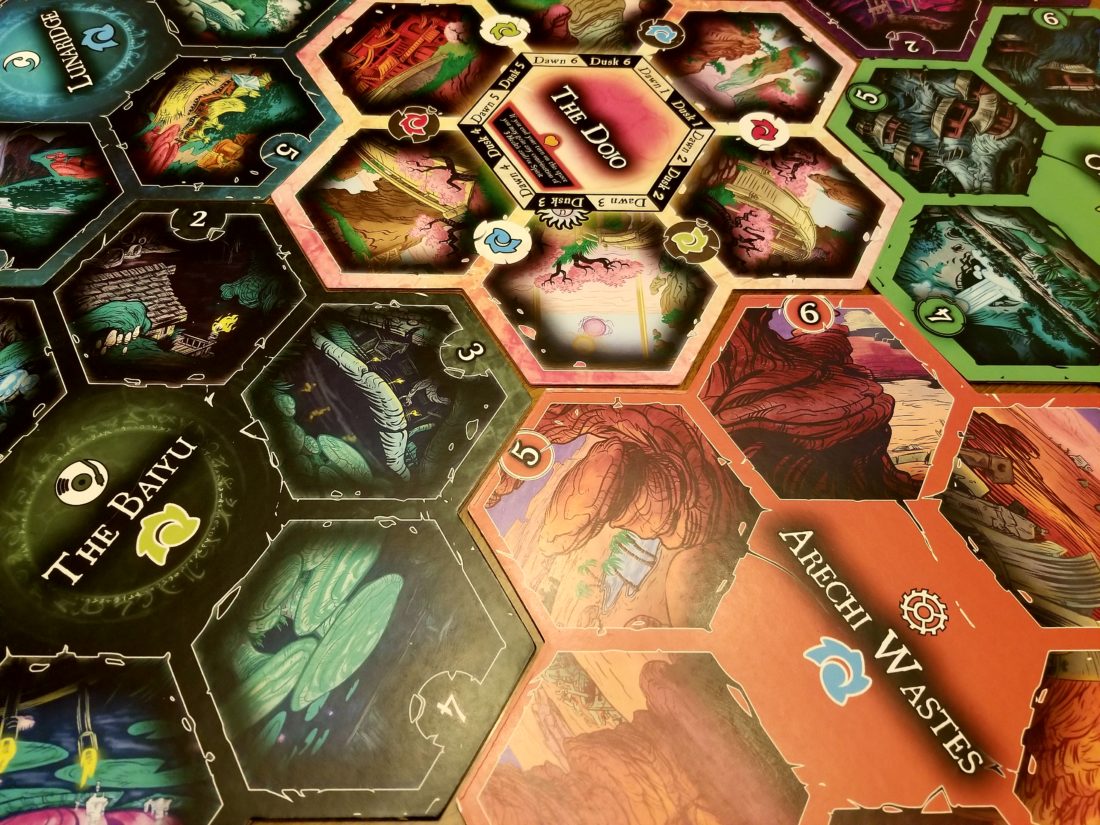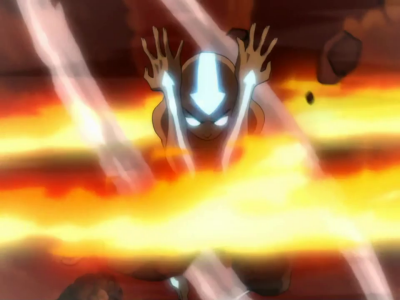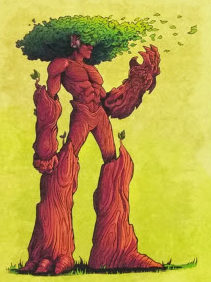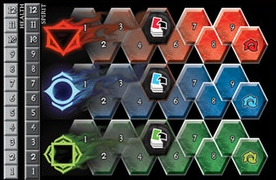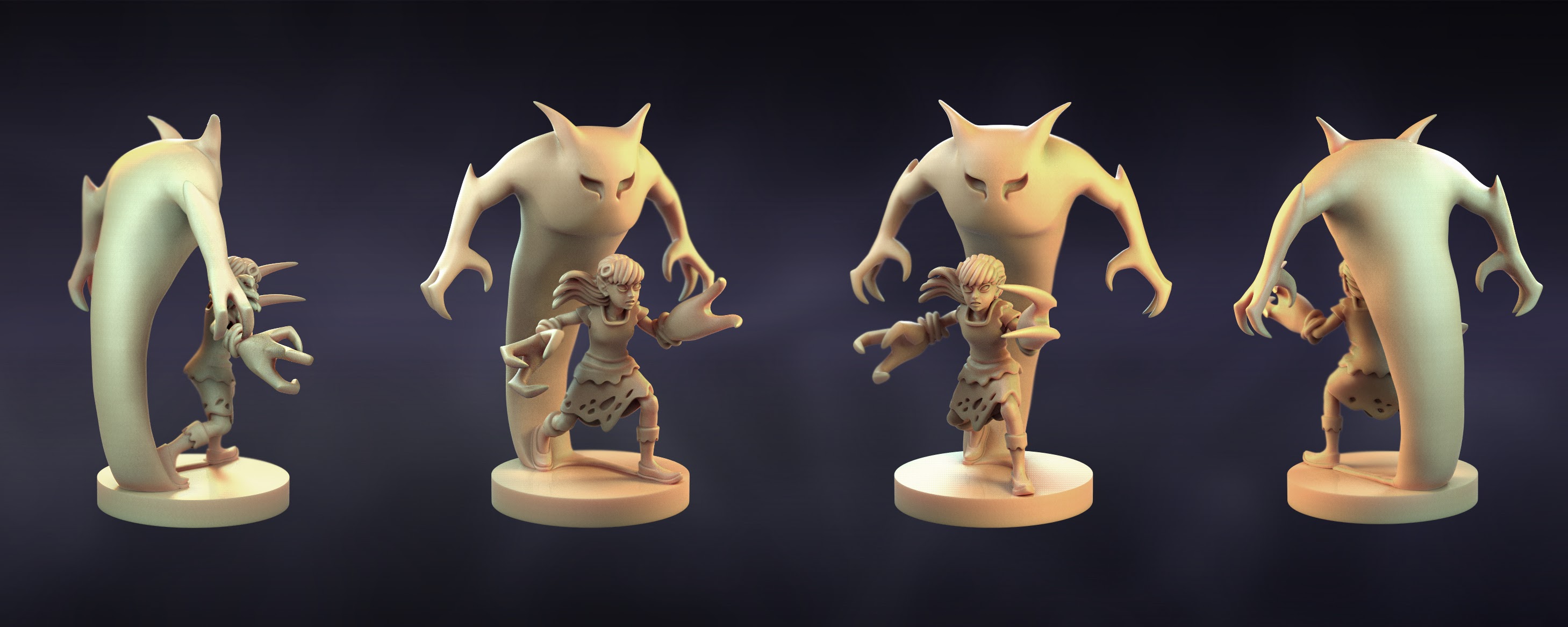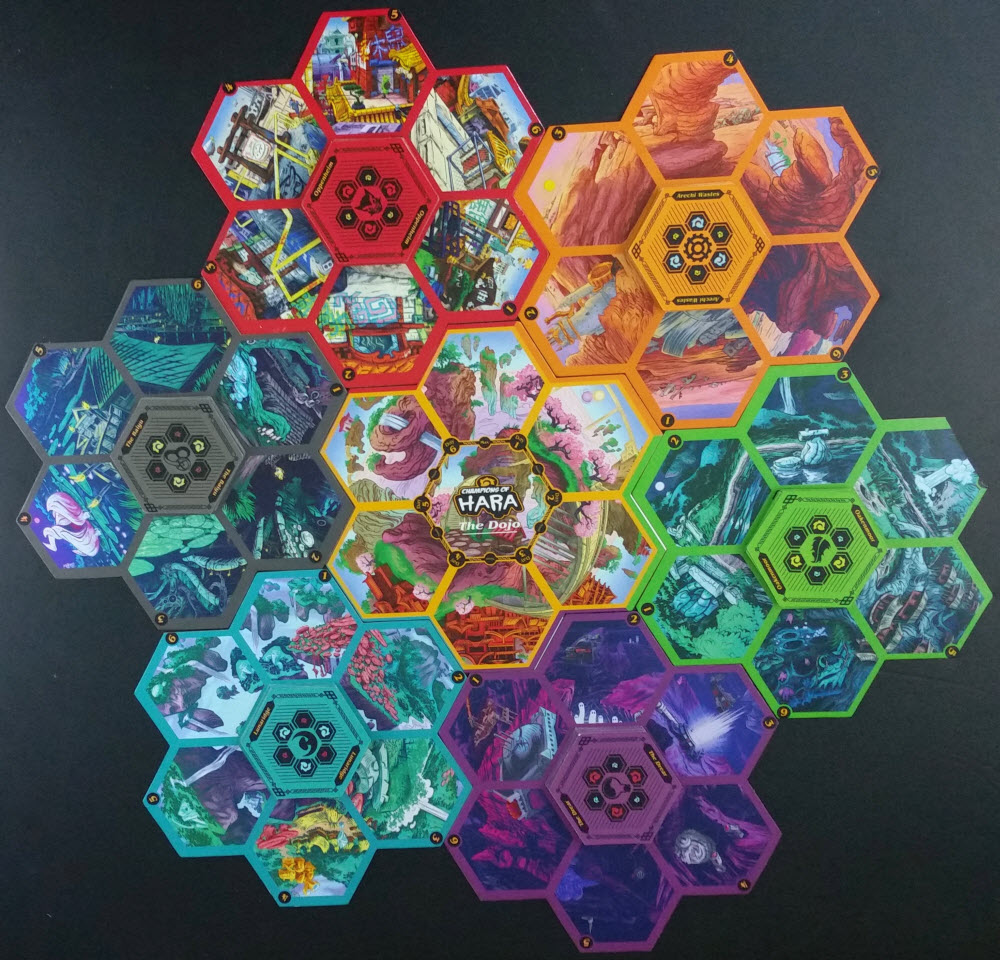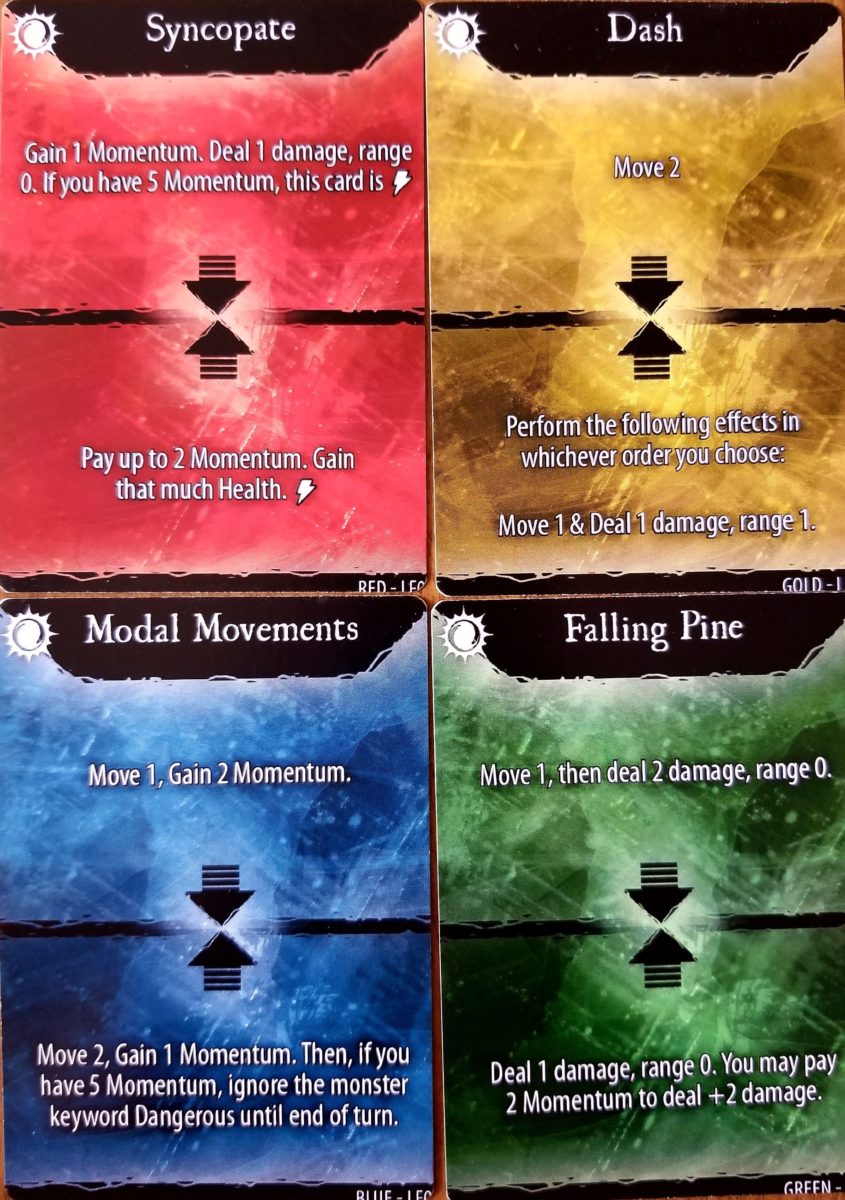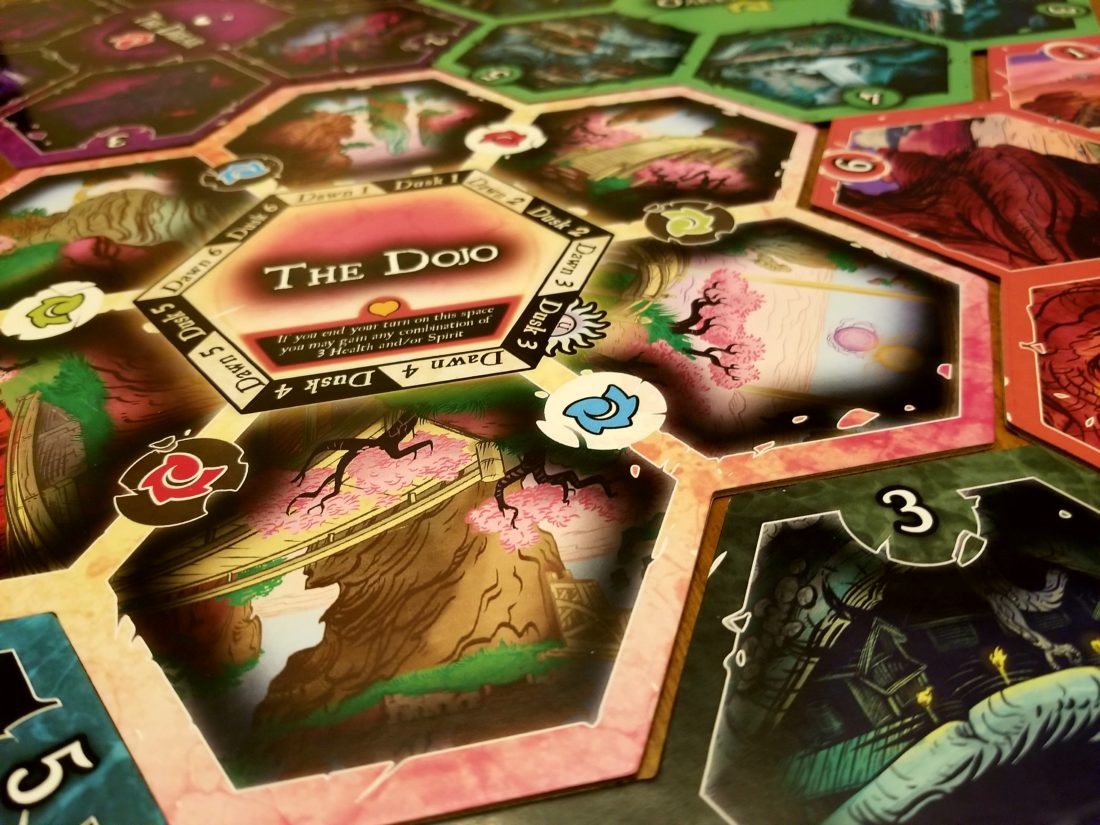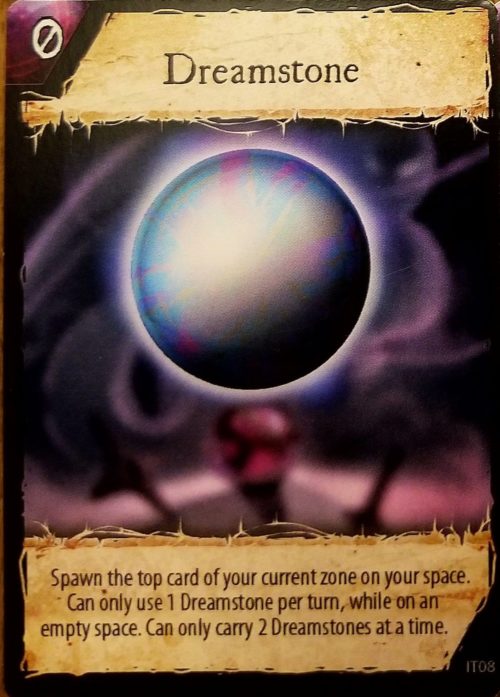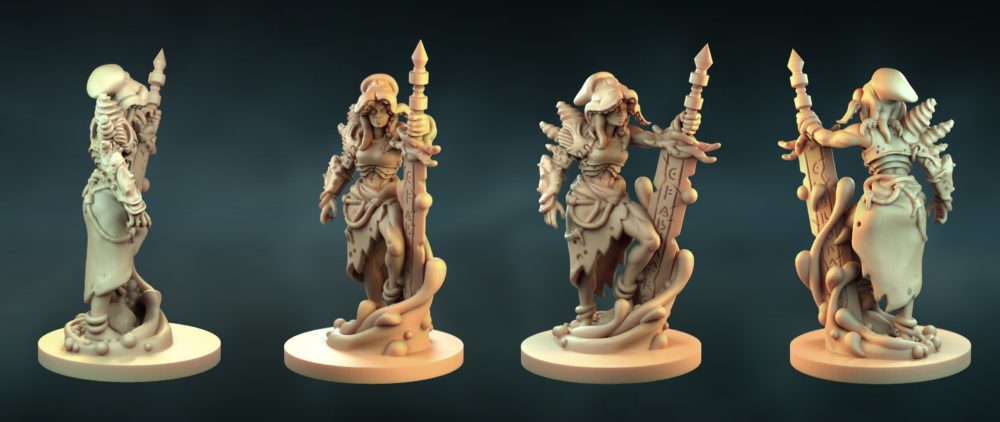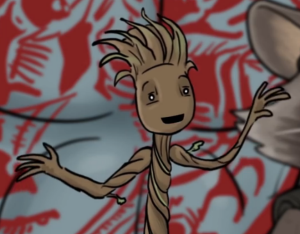Normally when we sit down to discuss a game that was on Kickstarter two years ago, we’re gearing up to provide a comprehensive critique of the finished product. This can be a fun experience as we get to look at the game through a fresh set of eyes and a completely different vantage point from when we last saw it.
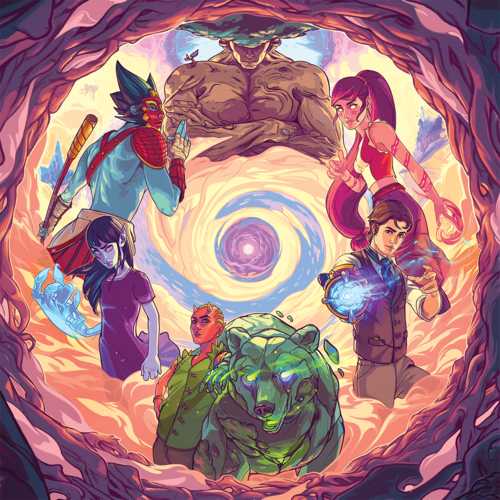 This is the first time, however, that we’ve ever been in the situation where we’re previewing the same game a second time. Yet that’s exactly what we’re doing here today with Champions of Hara.
This is the first time, however, that we’ve ever been in the situation where we’re previewing the same game a second time. Yet that’s exactly what we’re doing here today with Champions of Hara.
This isn’t a criticism. While the Champions of Hara we saw at the time had certifiable merit, it’s now returning to Kickstarter with a new set of tires. The original campaign ran successfully in 2015, but a series of events delayed its final production. Namely it was pulled under the Greenbrier banner shortly after the closing of the campaign and has undergone some significant development changes since in terms of its ruleset and component quality.
In short, while it has retained the core essence of Hara’s original theme, it’s nevertheless undergone a lengthy set of modifications since we last spoke about it. And it only seemed fair to address this improved iteration based on that.
But then we thought: how much does us reiterating much of what we’ve already said about Hara the first time really help before seeming redundant? What can we do this time around to provide useful context as to the game’s worth both to the new backer as well as those grandfathered in from the original campaign?
So here’s what we’re going to do: rather than simply rewrite the entire preview by scratch, today we’re instead going to look back at our original preview, referencing which aspects of this languished title have changed, and what has stayed the same.
Originally posted April 29, 2015
Don’t you hate it when you’re sitting there, minding your own business, and some crazy person opens up a portal to your world to proceed to ask for your help? Some world you’ve never heard of is in danger and they need you. They assure you the rewards will be worth it. Riches. Power. Fame. Glory. It’s yours if you succeed. Then you’re whisked off before you can even finish your turkey sandwich.
Boy, if I had a nickel…
So where have you been brought this time? Why to Champions of Hara: a resource gathering, monster slaying, energy hoarding game set in a world that’s one part plane of Zendikar, one part Wheel of Time, and one part The Last Airbender.
Fans of the original Champions of Hara have little to fear here. The core theme behind the game of a world in flux and people being pulled in from disparate locations to try to be its savior is largely unchanged since its last incarnation – which is good since this was the game’s primary draw for many to begin with. Essentially, if you liked the flavor of Hara the first time around, you’re good.
Champions is the inaugural release by Leaf Pile Media, where 2-6 players race against time – and each other – to solve a potentially catastrophic event on the world of Hara.
Since becoming part of the Greenbrier Games family, Hara’s retooling has including reducing the game’s current player max from 6 to 4. This may be disappointing to those who enjoy the added variety of additional players, but capping the core game at four ultimately should be seen as an improvement; one of the original version’s critiques was how long the game could drag at the higher player counts.
This world, like so many others with a strong magical undercurrent, has an absolute necessity for its energy forces to remain in balance with one another to maintain stability. Otherwise you end up with random energy rifts, elemental monsters, unstable terrain, and all of that will occur before afternoon tea.
So…guess what happened?
Yeah.
On Hara, every couple centuries or so the three primary energies of this artificial plane go completely sideways in an event known as the Conflux, unleashing all sorts of havoc as they spin out of control. Desperate, the people of Hara have recruited champions (the players) from a host of worlds in the hopes that one of them will be skillful enough to master all three energy sources before it is too late. In return, the person who can master the Conflux and restore balance will
become the new Avatarbe rewarded with untold powers.
Still the case mostly, albeit with a small bit of canonical retconning. In a slight shift, the Conflux has gone from a dangerous periodic imbalance on an unstable plane to a emblematic symptom of a dying artificial world that needs fixing. Apparently in their alterations, turning up the Doom! meter was also included.
The game begins with each player choosing a character, whether it’s someone like the ambitious pyromancer Sof, the steampunk-like engineer Thomas Evening, or the shadow mage Persephone and her pet Haunter. Hara actually does a great job representing the game’s flavor right out of the gate with them, depicting each of these people as strangers in a stranger land.
All of the game’s appealing and diverse cast of characters is still present, just waiting for their chance to be the Neo to Hara’s Zion.
At the beginning of this Highlander-like race for power, everyone starts with a player board. Everyone begins with 100 health and 3 Action Points to spend per turn. Players also begin with an energy storage of 5 and an attack power of 10. Additionally, all players have three adjustable Energy Alignment trackers.
These trackers come in the three colors that correspond to the three energy sources coursing through the world, and it symbolizes the energy frequency that your character is currently operating on at that moment. You continually adjust these Alignments throughout the game, and this mechanic is in many ways at the heart of how Hara functions. It’s a simple yet effective mechanic that works particularly well in its mixing of flavor and purpose.
This is the first substantive change of note to Champions of Hara. First off, player boards now just contain trackers for health and energy storage – which is no longer capped at 5. You no longer have to physically store energy cubes and run back to the Dojo; the energy is just absorbed by the character and its track goes up.
Attack Power as a mechanic has been removed entirely, which makes sense as combat has undergone a near complete overhaul. AP is instead replaced with a new resource called Spirit which is used to help pass various Events and close the all-important Rifts on Hara.
Furthermore, the rotating Energy Alignment trackers have also been scrapped. While this was a clever mechanism in concept, it often felt underdeveloped and underutilized, only being necessary to ensure certain cards in the game were at all useful to play.
However, as these characters are diverse in concept, so too are they in execution. Beyond the basics, Champions of Hara utilizes slightly asynchronous characters, the effect of which is felt more as the players grow in power. This is expressed through a deck of cards tailored to their champion, as well the Color Attunements field on their board. Functionally, one character works the same as one another, but as you would expect, a pyromancer and a giant sentient tree are going to want to do things a little differently. That is represented here.
This represents the second of the three largest changes to the game from its previous incarnation, as player card decks have been completely swapped out with a mere four basic Ability cards that you begin the game with. However, at the same time the new Champions of Hara doubles down on the asynchronous character gameplay by introducing a unique resource / trait for each character that boosts several of their Ability cards when utilized. Persephone is bolstered by Fear, for instance, and Thomas the tinkerer now leverages Relics to gain bigger effects.
On the one hand, this vastly reduces the variety of cards each player has to work with on any given turn. On the other hand, making this change also alleviates the issue some players used to run into with dead or ineffective turns due to poor luck of the draw. What’s more, the game makes up for the seeming loss of card variety by introducing an Item deck, with various equipment and one-shot cards that can be gained by defeating various monsters.
Because AP, card drawing, and hand size is now irrelevant, most of the original Color Attunement bonuses have also been largely eliminated. Instead, now upon collecting your fifth energy of a color, you gain a matching new Ability card of your choice from your Level Up cards. Bonus: you also don’t have to run back to the Dojo for that anymore either – it just automatically happens.
The splintered world of Hara itself is depicted through seven different boards. Six of these represent the various regions of Hara, with the center area – the Dojo – lying at the center.
Well, at first anyway.
The Dojo is generally a safe zone, free from the dangers of monsters or fellow competitors, and this is where everyone’s quest begins.
Before even leaving the Dojo, though, two things are very noticeable about Champions of Hara. Firstly, the game does a fantastic job with its artwork, with each region well decorated and distinctly different than one another. This says nothing of the artwork of the cards that will get revealed over the course of the game that heavily reinforce that fact, diminished only by occasional instances where lots of cards on the board can make everything look a little busy. The second thing is that Champions requires table space. Between the central boards, the player areas, and several component piles, Hara is a big place; a Coffee Table Game this is not.
All of this is still very much the case.
Once underway, the game is split into a series of rounds, called Days. Every Day, a new host of challenges are spawned for players to face. These are revealed from the Dawn and Dusk decks, respectively. These cards are randomly placed across the planes of Hara, as determined by rolling a pair of dice. While this can be a little tedious later in the game when you’re rolling eight or ten times per Day, this act also increases the unpredictable nature of a world being torn asunder. Dawn and Dusk cards both contain monsters to fight and rifts to close in exchange for the precious energy cubes you need to level up, with Dusk cards generally being more dangerous.

Hara Rifts.
Prototype Shown
The game still plays out over six Days, broken into Dawn and Dusk phases. The way the decks work is slightly different now, however. Each section has its own set of Dawn cards, which are assigned in an orderly fashion by matching the round0 number to the corresponding number space on that board. In this way, each location is now guaranteed a card every round. Monsters are still revealed face up in this way, while Events and Rifts are face down and only revealed when reaching that space.
That said, adding new cards during the Dusk phases is still as chaotic as ever, though that is now referred to as the Conflux deck.
Next, players choose turn order (think Archipelago, Viticulture, or Twilight Imperium), with every position besides going first bestowing a bonus for the round, such as gaining HP. As you’d expect, going first in Hara can be quite advantageous in grabbing a quick kill, for instance, but there are also plenty of times where the benefits of going later in the order are equally worthwhile. This system works especially well in Hara, giving the game an added degree of strategic depth, especially as competition between players ramps up.
Plus, who doesn’t love free stuff?
Once resolved, players take their turn according to turn order. Then they do it a second time. Turns in Hara are surprisingly fluid in terms of what you can do, which is both one of the game’s greatest assets and its one real hangup.
Gone. Gone. Gone. Turn order is now statically set and rotates every round. Being the first player has taken on a slightly more advantageous tenure than before, but this is offset by players two through four getting a once-per-Day bonus of some kind instead.
Also, players still get two turns per Day, but it’s more evenly staggered now: once during the Dawn phase and once during the Dusk phase.
Your three actions per turn can be spent on basic things like moving from one space to another, changing one of your Energy Alignments, closing a gate that matches your Energy Alignment, etc. However, three important things in the game are free actions: playing cards, leveling up, and Encounters.
Players still get to play three formal actions per turn, but most of what you can do is rolled into playing up to three Ability cards per turn. These cards still focus mostly on moving, dealing damage, and / or healing. The bigger change is which free actions are now (or still) available.
A player’s cards are incredibly useful, bestowing really potent effects. Every player starts with four cards, and you can use as many of them during your turn as you wish. Every card in the game has a normal effect, such as moving spaces or changing Energy Alignments, but many cards also have a much more powerful powered effect that can be used instead if a player’s Alignment match those listed on the card. And yeah, they’re worth it.
In Champions of Hara 2.0, every Ability card effect you have is useful, and this new approach alleviates lackluster cards effects. Instead of worrying about lining up Energy Alignments to make your cards beneficial, howver, the new hoop you jump through depends on where the card is located.
Every Ability card (with the exception of a powerful one-shot Ultimate bestowed to each player after Day 3) has two actions: one on the top and one on the bottom. To use the top action of an Ability card, you must play it from your hand to the board. To use the bottom action, you pick the card up from the board into your hand. The only catch is that you can only use each card once per turn.
That’s it.
The end result of this approach is that although you see far fewer cards each game, it’s now much more difficult to be unable to do anything. What’s more, there’s a lot of interesting synergy and combo potential in lining up top and bottom effects in the right order to explore. Our only concern here is that since between the base Ability cards, the Ultimate, and three Level Up cards gained, you’ll only have eight cards to work with each game. There’s plenty of options even amongst that amount, but it could be cool to see some additional card options in the future as a means of changing up strategies over time. Luckily, this new system is completely primed for such potentiality.
Leveling Up is as simple as journeying back to the center of the Dojo once you have enough energy cubes to fill up one of the lines on your board. These upgrades include things such as increased storage, more attack power, or powerful new cards. All of them are useful, but you have the complete freedom to pick and choose which to focus on.
Nope! No more MMO-style item ferrying back and forth to the Dojo. You now either go there to restore health and / or Spirit, to attempt to win the game, or if you die and have to respawn. Or to check out the view.
It’s a nice view.
The final free(ish) action is Encounters. If you’re in any empty region space but the Dojo’s, you can choose to have an Encounter there by drawing the top card of that region’s deck. These cards offer up story flavor, along with potentially good things (useful items!), or bad things (a monster appears!). These give off a distinctive vibe in the vein of Arkham Horror or Dead of Winter – in a good way. In Champions, though, you can continue having Encounters that turn at the cost of 1 AP each.
That, or until you come across a gate beyond your skill or monster who decides to eat your face.
First off, the new free abilities include using Items and taking advantage of your turn order bonus. “Having an Encounter” is still present, but it’s limited to once per turn and requires discarding an item called a Dreamstone. Each player starts with one per game, but more can be gained randomly throughout the game.
Encountering monsters – willingly or not – are also free actions. Congrats on that. Combat in Hara is fairly simple though. You fit the monster, then it hits you back. Generally, you keep doing that until one of you is dead. If the creature dies, you collect its energy. If you lose, you only become mostly dead. Yeah…death isn’t really a thing on Hara. Instead, you claim a removable Soul Wound, lose half your stuff, and respawn randomly to start again. Tough life, that.
Dealing with Dawn and Conflux cards feels largely the same, but there are small differences here too. Revealed Events or Rifts often involve a Challenge Rating, which consists of rolling a d6 and spending Spirit to overcome. You still gain an immediate energy reward for encountering them, and succeed often gets you more energy and / or Items. Failing Events still leads to bad stuff, though, so don’t worry about Hara getting all gentrified just yet.
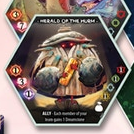
New Monster Layout
New Prototype Shown
Combat is similar. It now only consists of a single back and forth exchange of damage, done after you’ve taken all your actions for the turn. So now you can tangle with monsters in the wild and not get randomly murdered at every turn – hooray! In exchange, however, monsters have gained a number of keyworded abilities, making many a bit more potent than before. Killing them still nets you energy, but a good number also now provides specific Items.
If you do go and get yourself killed by a monster or player, you simply float back to the Dojo. No more losing stuff or Soul Wounds to wrangle with. Rather, your resurrection costs you two energy. Then you’re recorporealized and ready for action.
Having all these free actions gives a high degree of freedom and control to the player over how they want to take their turn, making for a dynamic adventuring experience every playthrough. However, this freedom comes at a cost, in that it isn’t the most streamlined process and can be tough for new players to grasp initially. Thankfully you can track AP on your board, as after several minutes of charging into battle and facing down a scaly beast, you may not accurately remember how many actions you have left.
With the new Ability card system, you still get a good amount of freedom and control, but it’s much easier for players to understand. The only hiccup can be tracking which Ability cards you have used on your turn, but the game provides a means to help with that too if needed.
After everyone finishes their second turn, the round ends by illustrating Hara’s innate instability. Here, a die roll determines which region physically switch places with the Dojo. This is admittedly a neat part of the game, but it can also be particularly fiddly picking up two board sections that may be littered with cubes, cards, and players, and move them elsewhere without knocking everything over. It’s a balancing act, but it does offer both a thematic and strategy-adjusting payoff.
Okay…yeah. We loved the idea of the board rearranging itself as part of representing the world’s instability, but it did get daunting happening every single round. Thankfully this has been cleaned up a bit.
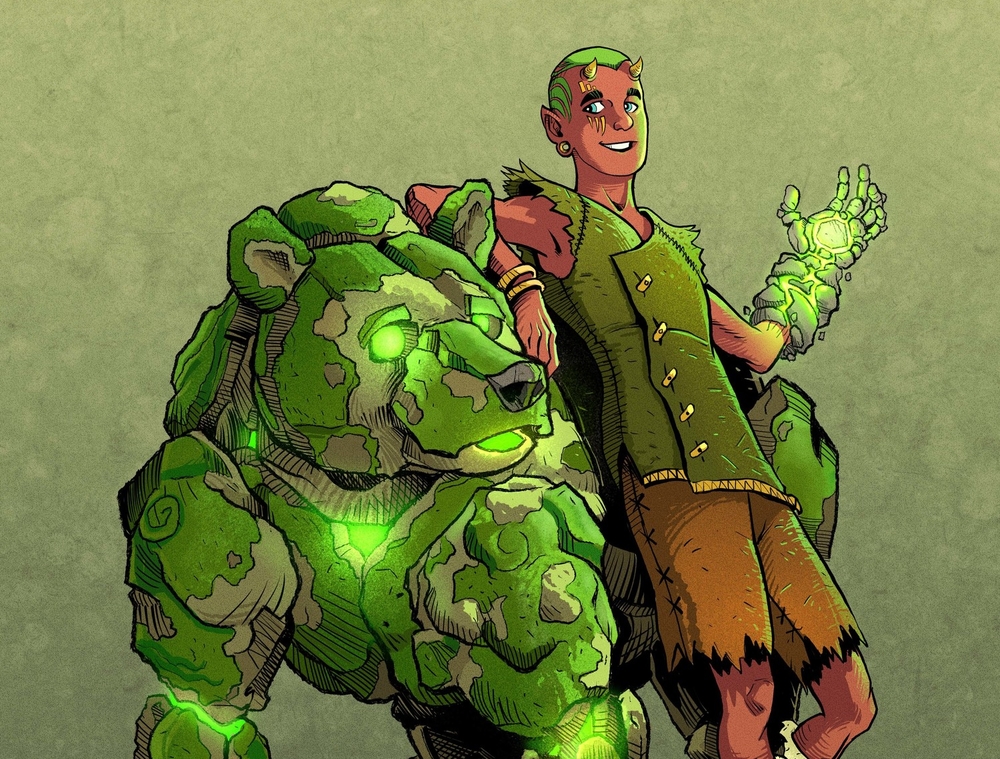 For one, there’s no more cubes on the board to worry about, meaning less clutter and tepidness when having to rearrange the board. And second, this rearranging no longer happens automatically. Instead, such shifts are tied to Events randomly found in the Conflux deck, and there’s only one Event for each location. This effectively means that each game the board will shift anywhere from 0-6 times, depending on whether players encounter those cards. This added randomness makes flavorful sense, and the reduction in frequency also keeps the novelty appeal of it from devolving into tedium.
For one, there’s no more cubes on the board to worry about, meaning less clutter and tepidness when having to rearrange the board. And second, this rearranging no longer happens automatically. Instead, such shifts are tied to Events randomly found in the Conflux deck, and there’s only one Event for each location. This effectively means that each game the board will shift anywhere from 0-6 times, depending on whether players encounter those cards. This added randomness makes flavorful sense, and the reduction in frequency also keeps the novelty appeal of it from devolving into tedium.
Although the Conflux is fully powered up after six Days, the game only ends once a player completes all of their normal upgrades plus their final one. The first player to do that absorbs the power of the Conflux and becomes the winner. Still, it feels strange that this super power Conflux event sort of stops at Day 6, even if it takes nine for someone to win.
Technically this is still true, but it’s very uncommon now for someone to not reach their energy goal by the end of Day 6, ensuring the game actually sort of ends when it’s supposed to. Yay expectations! When playing Scenarios, though, the game very much ends after six rounds no matter what.
Oh, right. Scenarios are new. But we’re getting to that.
As a result, the game can present the feeling of taking slightly longer than it should. Clocking in at about an estimated 30 minutes per player, Hara is on the same time commitment as some heavy Euro games. Yet Hara is not one, nor is it a co-op game, or one that’s directly combative. Hara is firmly an adventure and exploration game, where everyone running around doing their own thing, competing with one another over resources more than hit points. Though some potshots are possible.
Here comes the final major alteration to Champions of Hara. The observations made about the traditional winner take all style of the game are still mostly applicable, though the game’s refinement has certainly reduced the feeling of it dragging on to reach a conclusion. There’s a much larger sense of agency and control now, while also having less randomness for randomness’ sake.
But surprise! Champions will also come with a fully cooperative mode where players work together to overcome a central challenge as dictated by the chosen Scenario (usually involving defeating the Scenario’s boss monster). This is a huge and welcomed addition to the game. Not only does it give players who loved the theme but may have been turned off by the competitive nature a chance to explore the world as a team, but it also significantly increases the game’s replayability thanks to their variety and challenging nature. The base game comes with four Scenarios, but more are assuredly in the works.
Prototype components notwithstanding, Champions of Hara certainly could use a tad more fine-tuning to tighten up some of the game’s more minor concerns, but even taking those into account it’s evident that the fundamentals of this game are solid.
Completed.
The game does a remarkable job blending existing mechanics and overarching flavors together into something that is at once familiar territory while presenting a wholly original setting. The artwork and bevy of available decisions of Hara are particularly impressive, evoking the game’s comic-like adventure of trials and conquest without being too constrictive or devoid of purpose.
Check.
When combined with the randomness of card spawnings, Encounters, and the shifting board itself, this conflux of factors makes Champions of Hara a worthwhile and replayable immersive experience.
Check.
While it can be vexing for existing backers to not have gotten their game yet, this new version of Champions is well worth the wait. So many aspects of the game have been improved, streamlined, retooled, and rebalanced – not to mention this new version will come with visually appealing miniatures to boot. Yet this also gives new people a chance to explore a game that has come a long way from the rough-around-the-edges version last seen. The Champions of Hara iteration before you is vastly more worthwhile than before – and that’s saying something as the previous edition was still enjoyable in its own right. The game fixes the reservations many players had while upping the production quality and adding a whole new dynamic with Scenarios and cooperative play.
The portal to enter Hara is one again open. And you can find it right over on the game’s Kickstarter.
Photo Credits: Hara logos and images by Greenbrier Games; Avatar by Nickelodeon; Baby Groot by How It Should Have Ended.

